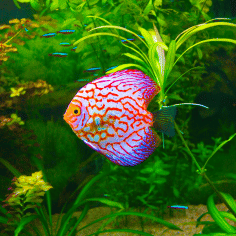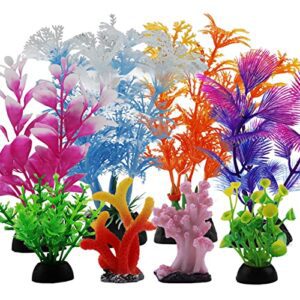Freshwater puffer fish are a captivating group of fish renowned for their unique ability to puff up when threatened. Among the various species, the Dwarf Pufferfish is often prized for its petite size and vibrant personality, suitable for smaller aquariums.
The Red Eye Puffer stands out with its striking appearance, making it a favorite for aquarists looking to add some flair to their tank. The Mbu Puffer, being one of the largest, commands attention with its size and requires a spacious habitat. Enthusiasts appreciate the Amazon Puffer for its spotted pattern and relative ease of care. Lastly, the Congo Puffer’s rarity and distinctive markings earn it a special place in the hearts of dedicated collectors. These species offer a blend of visual appeal and interesting behavior, but they all share a need for precise water conditions and a diet that includes hard-shelled foods to maintain their tooth health.
Introduction To Types Of Freshwater Puffer Fish
Distinctive Features
The freshwater puffer’s body is a marvel. Built like little submarines, they can control their buoyancy with ease. They have tough, elastic skin, but no scales. Their snout-like mouth is unique, with beak-like jaws to crunch hard-shelled prey. Notice their large, expressive eyes? They move independently, allowing them to spot food and predators quickly.Habitat Preferences
These puffers love warm, slow-moving waters. They seek out spaces with plenty of plants and hiding spots. They’re found in environments as diverse as African lakes and Asian rivers. Their habitats often have soft, sandy, or muddy bottoms. This is where they forage for snails and crustaceans. Let’s explore the different types of freshwater puffer fish and where they like to call home.
Types of Freshwater Puffer Fish: Discover Unique Varieties By Insiderfish.com
Dwarf Puffer Fish
Physical Characteristics
- Size: Typically grows to about an inch (2.5 cm).
- Shape: Round, balloon-like body.
- Gender Difference: Males often display a dark line down the middle.
- Colors: Vivid yellow-green with dark spots.
- Eyes: Can move independently.
Diet And Care
Providing the right diet and care will keep your Dwarf Puffer Fish healthy and happy. Their diet mainly consists of small invertebrates and some plant matter.| Food Type | Frequency |
|---|---|
| Snails | Daily to control teeth growth |
| Frozen Foods | 2-3 times per week |
| Live Foods | Occasionally as a treat |
- Provide a tank of at least 10 gallons for space to swim.
- Maintain clean, slightly acidic water (pH 6.5-7.5).
- Keep the water temperature between 72-79°F (22-26°C)
- Include lots of plants and hiding spots for comfort.
- Use a filter to keep the water quality high.
- Avoid placing with aggressive fish to prevent stress.
Mbu Puffer Fish
Giant Size Qualities
The Mbu Puffer Fish is the largest of its kind. It can grow up to 26 inches in length. Notable for its vast appetite, this puffer consumes various foods with its strong beak-like mouth. This gentle giant displays an intricate pattern across its body, sporting a yellowish background dotted with dark spots.| Characteristic | Detail |
|---|---|
| Max Size | 26 inches |
| Coloration | Yellow background with dark spots |
| Diet | Carnivorous |
| Mouth | Beak-like structure |
Aquarium Requirements
To house a Mbu Puffer Fish, aquarists must prepare a spacious tank. A minimum of 500 gallons is essential to ensure this fish has ample room to swim. Stable water parameters are crucial, including a temperature range of 76°F to 82°F and pH levels between 7.0 to 7.5. Adequate filtration systems help to maintain water quality, vital for the Mbu Puffer’s health.- Tank Size: Minimum 500 gallons
- Temperature: 76°F – 82°F
- pH Level: 7.0 – 7.5
- Filtration: Powerful and efficient
- Water Quality: Pristine conditions required

Fahaka Puffer Fish
Nile Puffer Attributes
The Fahaka Puffer boasts a distinctive look. Its body sports an array of eye-catching stripes and spots. This fish typically grows to a length of about 17 inches in captivity. Here are some quick facts:- Scientific Name: Tetraodon lineatus
- Average Lifespan: Up to 10 years
- Preferred Habitat: Large tank with plenty of hiding spaces
- Ideal Diet: Mollusks, crustaceans, and other hard-shelled foods
| Parameter | Requirement |
|---|---|
| Water Temperature | 24-28°C (75-82°F) |
| pH Level | 7.0-8.0 |
| Water Hardness | 8-15 dGH |
Interaction And Behavior
The Fahaka Puffer’s behavior is both curious and interactive. They often develop a strong bond with their caretaker. These puffers can exhibit territorial tendencies, so careful attention is necessary when introducing tank companions. Suitable tank mates include:- Large, passive fish
- Bottom dwellers less likely to compete for space
Red Eye Puffer Fish
Meet the fascinating Red Eye Puffer Fish, a favorite among freshwater aquarium enthusiasts. This little puffer fish brings a splash of color and personality to any tank. Known scientifically as Carinotetraodon lorteti, these fish are small in size but big on charm with their unique red eyes that sparkle like jewels.
Appearance And Size
The Red Eye Puffer Fish is easily recognizable. With a backdrop of green and yellow, their body shimmers in the light. The unmistakable red eyes stand out, giving these fish their name. Spots and patterns vary from individual to individual, presenting a delightful display.
| Characteristic | Description |
|---|---|
| Color | Green and yellow with a unique pattern |
| Defining Feature | Striking red eyes |
| Size | Averages at 2.8 inches (7 cm) in length |
Environmental Needs
Red Eye Puffers thrive in specific conditions. They prefer warm, slightly acidic water with a pH between 6.5 and 7.2. Gentle filtration is essential to prevent the stress of strong currents. Though small, they require space for swimming and hiding.
- Temperature: 74°F to 79°F (23°C to 26°C)
- pH Level: 6.5 – 7.2
- Minimum Tank Size: 15 gallons
Plants and hiding spaces are a must. They provide the Red Eye Puffer with a sense of security. Remember to change a portion of the tank’s water weekly to keep it clean and keep your puffer fish healthy.
Amazon Puffer Fish
South American Species
Colomesus asellus, the Amazon Puffer, stands out in the puffer world. Unlike their marine cousins, these puffers live in freshwater throughout the Amazon Basin. They can grow up to 5 inches (12 cm) in length. Their diet mainly consists of:- Snails
- Mollusks
- Crustaceans
Group Dynamics
Amazon Puffers are known for their social behavior. In the aquarium, they often do best in small groups called shoals. These group dynamics can prevent stress and provide your puffers with a stimulating environment. For optimal group interactions:| Group Size | Tank Size | Benefits |
|---|---|---|
| 3-5 Puffers | Minimum 30 gallons | Encourages natural behavior |
| 6+ Puffers | Minimum 50 gallons | Reduces aggression |
Congo Puffer Fish
African Origin
The Congo Puffer Fish, also known as Tetraodon miurus, hails from the Congo Basin. Its habitat spans across rivers and streams, where the water is clear and movement is slow. Adapted to these freshwater environments, the Congo Puffer’s colors and patterns mimic the sandy riverbeds, helping it blend in to avoid predators.Temperament And Feeding
The Congo Puffer’s temperament can be quite variable. While some may show a more docile nature, others display territorial behaviors. This species is known for its intelligence and can recognize their caretakers. Although generally peaceful, they can get aggressive with tank mates when feeling threatened or during meal times. Feeding the Congo Puffer involves a diet of hard-shelled invertebrates to maintain healthy teeth. In captivity, they eagerly consume:- Snails
- Crustaceans
- Shellfish
Pea Puffer Fish
Meet the Pea Puffer Fish, a jewel in the world of freshwater aquariums. These tiny puffers bring personality and intrigue to any tank. Let’s discover the fun and care that goes into raising pea puffers.
Smallest Specimen
The Pea Puffer, also known as the Dwarf Puffer, stands out as the smallest puffer fish found in freshwater. Fully grown, they reach just an inch and a half! Their size is perfect for small tank living.Tank Setup Tips
Setting up a home for a Pea Puffer takes special care. Here are some essentials:- Tank Size: Start with a 5-gallon tank for a single puffer to give them the space they need.
- Water Quality: Keep the water clean and well-filtered. Use a filter with a gentle flow to mimic their natural habitat.
- Decoration: Add plants and hiding spots. Pea Puffers love an environment with complexity.
- Tank Mates: Caution with companions. These puffers can be territorial. Opt for larger, peaceful species if you wish to add tank mates.
| Parameter | Optimal Range |
|---|---|
| Temperature | 77-79°F (25-26°C) |
| pH Level | 7.0-7.5 |
Golden Puffer Fish
Unique Coloring
The Golden Puffer Fish, also known as Auriglobus modestus, boasts a stunning gold-yellow body. It captivates onlookers with iridescent patches that shimmer under aquarium lights. Such mesmerizing color patterns ensure this puffer’s status as a centerpiece in any tank setup.Special Care Considerations
Giving these creatures a proper home calls for precise parameters. Golden Puffer Fish require a balanced diet including snails and crustaceans to sustain their beak-like teeth. Their water needs close monitoring, with acidity levels (pH) kept between 7.0 and 7.6 and temperatures from 76-80°F.- Diet: Varied, including live prey
- Water pH: 7.0 – 7.6
- Temperature: 76-80°F
- Tank Size: Minimum 30 gallons
Keeping Puffer Fish
Aquarium Safety
Ensuring a secure home for puffer fish starts with the aquarium set-up:- Tank size should cater to specific species needs.
- Use well-cycled water to keep ammonia levels in check.
- Plenty of hiding spots and soft substrate mimic their natural habitat.
- Tight-fitting lids prevent escape, as puffers are known jumpers.
Health And Wellness
Maintaining puffer fish health involves:- Regular water tests for optimal water conditions.
- A varied diet, including snails and shellfish for beak maintenance.
- Observing for changes in behavior or appearance, which indicate health issues.

Frequently Asked Questions On Types Of Freshwater Puffer Fish
How Many Types Of Freshwater Puffer Fish Are There?
There are approximately 30 known species of freshwater pufferfish. Each species varies in size, color, and habitat requirements.
What Is The Most Peaceful Freshwater Puffer Fish?
The Dwarf Puffer Fish, also known as the Pea Puffer, is the most peaceful freshwater puffer fish species, ideal for serene aquarium settings.
What Is The Best Freshwater Puffer Fish To Keep As A Pet?
The best types of freshwater puffer fish for a pet is the Dwarf Puffer, also known as Pea Puffer. They are small, active, and relatively easy to care for in a well-maintained tank.
What Is The Most Aggressive Freshwater Puffer?
The Fahaka puffer (Tetraodon lineatus) ranks as the most aggressive freshwater puffer species, known for its territorial nature.
Conclusion
Exploring the diverse realm of freshwater puffer fish reveals a fascinating underwater tapestry. Each species, from the dwarf puffer’s charm to the giant puffer’s majesty, adds a unique brushstroke. Enthusiasts are urged to consider care requirements and environmental impact prior to inviting these captivating creatures into their aquatic families.
Embrace the wonders of freshwater puffers and enrich your aquarium with their unexpected grace.



























